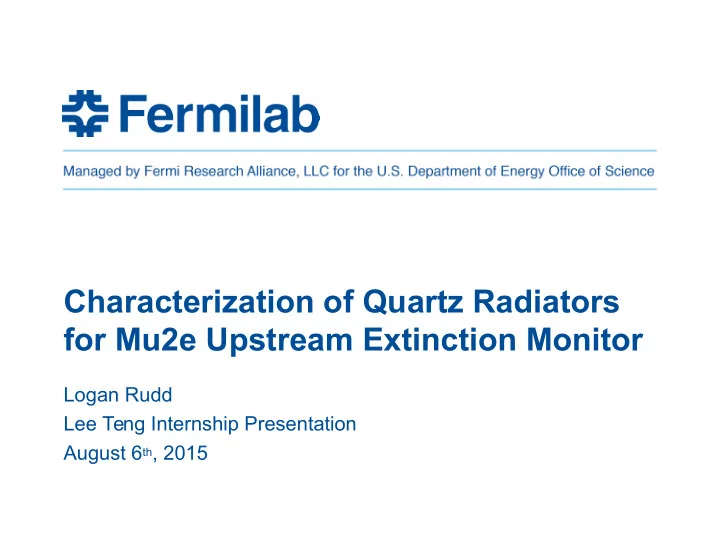

Characterization of Quartz Radiators for Mu2e Upstream Extinction Monitor Logan Rudd Lee Teng Internship Presentation August 6 th , 2015
Overview • CLFV and the Mu2e experiment • Extinction monitoring and quartz radiators • Cosmic ray telescope • DAQ and NIM setup • Results and discussion • Future Work
Charged Lepton Flavor Violation (CLFV) • SM requires preservation of leptonic flavor numbers neutrinos were massless. • LF numbers are only approximate. • Lepton conservation laws must hold for interactions containing charged leptons. • Should be possible to observe rare decays such as ¹N → eN . • Opens up many new models of physics
Mu2e Experiment • Will measure the ratio of direct conversion of muons to electrons in the presence of a nucleus with respect to the rate of typical muon capture, Four orders beyond SINDRUM II, with R μe ≈ 2.87 x 10 -17 . •
Extinction Monitoring • Target Extinction Monitor and Upstream Extinction Monitor – Measure extinction on the level of 10 -10 and 10 -5 respectively
Upstream Extinction Monitor • Placed in M4 beam line. • Designed to use a series of quartz radiators connected to PMTs • Quartz radiators chosen over scintillators for three main reasons: – Blind to soft particles (eg: muons < 50MeV) – No intrinsic after pulses – Fast response time
Cosmic Ray Telescope • Stands were constructed using Unistrut metal framing. • Main components connected to PMTs are: – (3) 1cm x 1cm x 0.5cm scintillators – (1) 2cm x 2cm x 0.5cm quartz radiator
NIM and DAQ Setup • Nuclear Instrumentation Modules (NIMs): – Discriminator, Fan In / Fan Out, Logic Units, Scalers – Filter out noise – Count both triple coincidences and accidental triple coincidences. – Provide external trigger for scope • C++ program configures scope and stores triggered events for later analysis.
NIM and DAQ Setup (cont.) • Data was collected with both vertical and horizontal orientations of the quartz radiator.
Results (Vertical Orientation) • Scaler showed 130 triple coincidences and 3 accidental triple coincidences. • Data analysis shows that about 36% of triggered events are quadruple coincidences. • Rate of 1.11 quadruple coincidences/hour over ~40.5 hours. Ch. 1 Ch. 2 Ch. 4 Ch. 3
Results (Horizontal Orientation) • Scaler showed 66 triple coincidences and 8 accidental triple coincidences. • Data analysis shows that about 72% of triggered events are quadruple coincidences. • Rate of 1.48 quadruple coincidences/hour over ~26.3 hours. Ch. 2 Ch. 1 Ch. 3 Ch. 4
Discussion and Conclusion • Time was mostly spent developing and optimizing telescope, and NIM and DAQ setup, including C++ programs. • Geometry of telescope and particle energies are the largest factors for quadruple coincidences. • Preliminary results are very rough figures: – Scalers don't agree with number of records – Little data collected – Accidental rates are too few and not recorded by DAQ • Expect rates for muons > 1GeV: – 0.64/hour (Horizontal Orientation) – 0.16/hour (Vertical Orientation) • Large signals from quartz: – Mean of scintillator signals ~77mV – Mean of quartz signals ~450mV/740mV
Future Plans • Implement another quartz radiator. • Implement 2” lead brick to filter out muons below 100MeV. • Improve analysis code to filter out high voltage signals from scintillators. • Look at ms after pulses associated with the PMTs.
Acknowledgements • Illinois Accelerator Institute • US Particle Accelerator School • Particularly grateful for my mentor Eric Prebys, for his dedicated assistance and guidance. • Special thanks to: – Mu2e collaboration – Tanja Waltrip – Eric Ramberg – Roger Dixon
Vertical Cosmic Flux
Recommend
More recommend